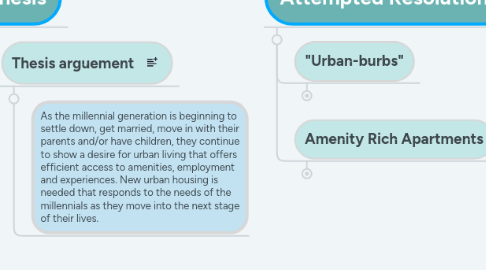
1. Millennials
1.1. Who Are They
1.1.1. Demographics
1.1.1.1. Born 1982-2000
1.1.1.1.1. Between the ages of 19-37
1.1.1.2. Population +80 million
1.1.1.2.1. Largest adult population
1.1.1.3. Traits
1.1.1.3.1. Desire for urban lifestyle
1.1.1.3.2. Environmentally conscious
1.1.1.3.3. Disconnected from traditions & institutions
1.1.1.3.4. Evolving family unit & lifestyle
1.1.1.3.5. Changing stages of life
1.1.1.3.6. Disengaged from material status
1.1.1.3.7. More Urban
1.1.1.3.8. More Diverse
1.1.1.3.9. First Generation Predicted Not to Be better of Than Their Parents
1.1.1.3.10. Connected through Social Media
1.1.1.3.11. Highly Educated
1.1.1.3.12. High Rate of Unemployment
1.1.1.3.13. Low Pay
1.1.1.3.14. Less religious
1.1.1.4. Values
1.1.1.4.1. Desire for Urban Lifestyle
1.1.1.4.2. Experience
1.1.1.4.3. Expediency
1.1.1.4.4. Authenticity
1.1.1.4.5. Work/life symbiosis
1.1.1.4.6. Purposeful
1.1.1.4.7. Personal Growth & development
1.1.1.4.8. Coaching
1.1.1.4.9. Conversations
1.1.1.4.10. Healthy Lifestyle
1.1.2. Why?
1.1.2.1. Housing Bubble
1.1.2.2. Unemployment
1.1.2.3. Student Loan Debt
1.1.2.4. Recesion & Bailouts
1.1.2.5. Technology
1.1.2.5.1. Internet
1.2. What Are they Doing
1.2.1. Changing Stages of Life
1.2.1.1. Establishing families
1.2.1.2. Setting roots
1.2.1.3. Starting Careers
1.2.2. Priced out of urban enviroments
1.2.2.1. Moving to Mid-sized cities
1.2.3. Moving to Suburbs in consolation
1.2.3.1. Lack of housing options to fit their lifestyle are incentivizing moves to the suburbs
1.3. What Do They Want
1.3.1. Experiences
1.3.1.1. 78% would prefer to spend money on an experience vs buying something desireable
1.3.2. Homeownership
1.3.2.1. 2015 study found that 70% of millennial's expect to be homeowners by 2020
1.3.3. Urban lifestyle
1.3.3.1. Walk-able neighborhood
1.3.3.2. Alternative transit options
1.3.4. Foster Growth
1.3.4.1. Family
1.3.4.2. Proffesional
1.3.4.3. Personal
2. The Problem
2.1. Lack or Appropriate housing
2.1.1. New Stage of Life
2.1.1.1. Apartment construction outpaces singlefamily construction
2.1.1.2. Most new Urban housing focuses on creating "luxury" amenity rich developments
2.1.1.3. New housing
2.1.2. Values
2.1.3. Urbanism
2.2. Increasing Urban Housing Costs
2.2.1. Millennials unable to afford urban lifestyle
2.3. Suburbanized mid-sized cities
2.3.1. Migration to more affordable cities
2.4. Suburban Legacy
2.4.1. Evangelicism
2.4.2. Segregation
2.4.2.1. Economic
2.4.2.2. Racial
2.4.2.3. Cultural
2.4.3. Domesticity
2.4.4. Work/life separation
2.4.5. Consumerism & Status
2.4.6. Exclusionary design
3. Thesis
3.1. Thesis arguement
3.1.1. As the millennial generation is beginning to settle down, get married, move in with their parents and/or have children, they continue to show a desire for urban living that offers efficient access to amenities, employment and experiences. New urban housing is needed that responds to the needs of the millennials as they move into the next stage of their lives.
4. Attempted Resolutions
4.1. "Urban-burbs"
4.1.1. What works
4.1.2. What doesnt work
4.1.2.1. Economy
4.1.2.2. Transit
4.2. Amenity Rich Apartments
4.2.1. What works
4.2.2. What doesnt work
4.2.2.1. Amenities
4.2.2.1.1. Increase in housing cost
4.2.2.1.2. Underutilized
4.2.2.1.3. Exclusive to Residents
4.2.2.2. Inauthenticity
4.2.2.2.1. Community
4.2.2.2.2. Architecture
4.2.2.2.3. Public space
4.2.2.2.4. Nature
5. Proposed Solution
5.1. Goals
5.1.1. Connections
5.1.1.1. Social Capital
5.1.1.2. Transit
5.1.1.3. Experiences
5.1.1.4. Enviroment
5.1.1.5. Community
5.1.2. Living
5.1.2.1. Unique
5.1.2.1.1. Retainability
5.1.2.1.2. Experiential
5.1.2.1.3. Work/life Symbiosis
5.1.2.1.4. Enviroment
5.1.2.2. Shared
5.1.2.2.1. Greenspace
5.1.2.2.2. Affordability
5.1.2.2.3. Safety
5.1.2.2.4. Privacy
5.1.3. Growth
5.1.3.1. Safety
5.1.3.2. Experiences
5.1.3.3. Personal Development
5.1.3.4. Professional Development
5.1.3.5. Community
5.1.3.6. Urban
5.1.3.7. Aging
5.1.3.8. Repeatable Concept
6. Site Selection
6.1. Selection Of City
6.1.1. Cost of Living
6.1.1.1. Median Income
6.1.1.2. Median Home Price
6.1.2. Good Economy
6.1.2.1. Opportunity for professional growth
6.1.2.2. Good economic/employment outlook
6.1.3. Existence of major amenities
6.1.4. Established Urban Core
6.1.4.1. Vibrant urban core that is attractive millennials
6.1.5. High population growth
6.1.5.1. +17% 2010-2017
6.1.6. Suburbanized city
6.1.6.1. Conditions incentivize moving to the suburbs
6.1.7. Diversity
6.1.7.1. Cultural, ethnic, racial etc.
6.1.8. Attractiveness
6.1.8.1. Millennial appeal
6.1.9. Public transit
6.2. Selection of City District
6.2.1. Housing prices
6.2.2. Employment
6.2.3. Crime
6.2.4. Transit
6.2.5. Amenities
6.2.5.1. University
6.2.5.2. Garden
6.2.5.3. Parks
6.2.5.4. Movie Theater
6.2.5.5. Resaraunts
6.3. Selection of the Site
7. Intervention
7.1. Human Scale
7.1.1. Housing
7.1.1.1. Expediency
7.1.1.1.1. efficient space design
7.1.1.2. Personal growth/development
7.1.2. Street Scape
7.1.2.1. Pedestrian friendly design
7.1.2.2. Materiality
7.2. Building Scale
7.2.1. Housing
7.2.1.1. authenicity
7.2.1.1.1. raw materials
7.2.1.1.2. Intentional design
7.2.1.2. Work/life symbiosis
7.2.1.2.1. Workspace
7.2.1.3. Affordability
7.2.1.3.1. Standardize Unit increments
7.2.1.3.2. Modular construction
7.2.1.4. Access
7.2.1.4.1. Pedestrian
7.2.1.4.2. Vehicle
7.2.1.5. parking
7.2.1.5.1. off site parking
7.2.2. Public space
7.2.2.1. street connection
7.2.2.2. Urban Scale
7.3. Neighborhood Scale
7.3.1. Program
7.3.1.1. Housing
7.3.1.2. Retail
7.3.1.3. Parking
7.3.1.4. Public Space
7.3.1.5. Transit
7.4. District Scale
7.4.1. Program
7.4.2. Transit
7.4.3. Social Capital
7.4.4. Economic
7.4.5. Street Sections
7.5. City Scale
7.5.1. Transit
7.5.2. Economic
7.6. National Scale
7.6.1. Repeatable concept
7.6.2. Social Capital
7.7. Global Scale
7.7.1. Enviromental Impact
